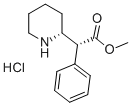Description
Dexmethylphenidate, the pharmacologically effective enantiomer of d,l-methyl
phenidate (Ritalin?) was developed as an improved treatment for attention deficit
hyperactivity disorder (ADHD) in children. Dexmethylphenidate acts via the inhibition of
reuptake of dopamine (by binding to dopamine transporter) and nor-adrenaline. It is thought
to block dopamine and noradrenaline reuptake into the presynaptic neuron and increase
neurotmnsmitter release into the extraneuronal space. Dexmethytphenidate, at half the
usual dose of racemic methylphenidate, improved the symptoms of attention deficit
hyperactivity disorder to a similar extent to methylphenidate in both home and school
settings (SNAP-ADHD scores) at 3 h post dosing. Moreover, some studies showed that
dexmethylphenidate has a statistically significant longer duration of action than the racemic
form as measured by a behavioral scale at 6 h post dosing compared to placebo. In
patients with ADHD, plasma dexmethylphenidate concentrations increased rapidly,
reaching a maximum in the fasted state at approximately l-l.5 h post-dose. The mean
plasma half-life for dexmethylphenidate is approximately 2.2 h. Dexmethylphenidate is
metabolized to d-α-phenyl-piperidine acetic acid, its main urinary metabolite which has
negligible pharmacological activity. In vitro studies showed that dexmethylphenidate did
not inhibit cytochrome P450 isozymes. Dexmethylphenidate was well tolerated; the most
commonly reported adverse events (abdominal pain, headache, anorexia, insomnia) were
mild in severity and consistent with those known to be associated with agents containing
methylphenidate. Current labeling states that dexmethylphenidate should be administered
twice daily with an interval of at least 4 hours between doses. Stimulant medications have
been used for over sixty years and remain, until now, the first line pharmacological therapy
for children with ADHD, demonstrating effectiveness in roughly 70% of patients.
